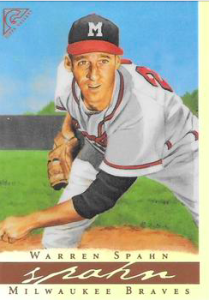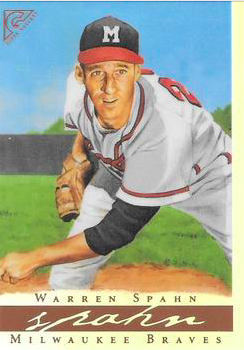April 13, 1957: Braves and Millers put on a cold-weather exhibition in Minneapolis

The Milwaukee Braves and the Minneapolis Millers were both optimistic heading into their 1957 seasons.
The Braves, who had finished one game behind National League champion Brooklyn in 1956, were the favorite to win the 1957 pennant, according to an Associated Press poll.
“The club looks good,” said Braves manager Fred Haney, “I feel we have a club that can win this year.”1
The Millers, who finished fourth in the American Association in 1956 – their first season at Metropolitan Stadium, were looking for improvement in 1957 with a lineup that featured Felipe Alou, Orlando Cepeda, and Jim Davenport.
Three days before the Braves and Millers were scheduled to open their respective seasons on the road – the Braves in Chicago and the Millers in Indianapolis – they stopped by Metropolitan Stadium for an exhibition tune-up.
The Braves, who trained in Bradenton, Florida, broke their training camp on April 2 and played exhibitions in Jacksonville, San Antonio, Houston, Dallas, Fort Worth, Oklahoma City, Tulsa, Wichita, and Topeka before reaching Minnesota with a 19-10 exhibition record. The Braves were the third major-league team – following the New York Giants and Cleveland Indians in 1956 – to play an exhibition game against the Millers at Metropolitan Stadium.
The Millers, who trained in Sanford, Florida (just outside of Orlando), were 12-6-2 in Florida exhibitions – a record that was highlighted by Alou’s .360 batting average and Cepeda’s .356 average with 20 runs batted in.
The Braves had a simple approach going into the Saturday afternoon game against the Millers.
“It was a cold day,” said Braves pitcher Lew Burdette. “Our big interest was trying to get the game over as fast as we could.”2
With a game-time temperature of 36 degrees, the Braves used their regular lineup except for third baseman Eddie Mathews, who was in New York for a promotional date. The Braves were managed in Minneapolis by coach Charlie Rootbecause Haney was at his home in Milwaukee recuperating from the flu.
The teams met Burdette’s goal by playing the game in an efficient, 1 hour 57 minutes.
Braves pitchers Bob Buhl, Warren Spahn. and Burdette combined to hold the Millers hitless for 8⅓ innings before hanging on for a 4-3 victory.
Buhl, a right-hander who had a won-lost record of 18-8 with a 3.32 earned-run average for the Braves in 1956, breezed through the first three innings, allowing two baserunners, issuing walks to Cepeda in the second and Alou in the third.
Spahn, who was 20-11 in 1956 (his seventh season of winning 20 or more games since 1947), allowed just one baserunner in the middle three innings. He walked Davenport with one out in the fourth inning but then coaxed Carlos Paula to hit an inning-ending double-play grounder.
Burdette, who was 19-10 with a 2.70 ERA and NL-leading six shutouts in 1956 and was 62-37 with the Braves since they relocated from Boston before the 1953 season, took over in the seventh. The Millers got a baserunner after a Braves error with two outs in the seventh, but Cepeda flied out to right for the third out.
Burdette retired the Millers in order in the eighth and retired pinch-hitter Lee Tate on a fly ball to left for the first out in the ninth.
Millers shortstop Eddie Bressoud then topped a ball down the third-base line and beat third baseman Felix Mantilla’s throw for Minneapolis’s first hit, then went to second on Mantilla’s throwing error. Wayne Terwilliger reached on infield hit, and Bressoud took third.
Davenport’s sacrifice fly to center scored Bressoud to make the score 4-1. Paula then drove a low slider from Burdette over the left-field fence and it was 4-3, Braves.
Burdette regrouped and got Cepeda to ground out for the final out.
“Actually, we weren’t paying any attention to the fact they didn’t have a hit,” Burdette said. “The no-hitters don’t mean anything in spring training and especially when three pitchers have thrown.”3
Burdette said the pitch to Paula was a mistake.
“Funny thing about Paula’s home run,” he said. “[Catcher] Carl Sawatski signaled for a curveball. As I started to wind up, I forgot what he had asked for. So, I let go of a nothing ball and Paula hit it out of the park.”4
The Braves built their 4-0 lead off Millers starter Joe Shipley, who was a month shy of his 22nd birthday and was 8-19 in 1956 with Johnstown in the Class A Eastern League, and veteran Mike Blyzka.
The Braves opened the scoring with a run in the first on successive doubles by Henry Aaron, who had led the NL with a .328 batting average in 1956, and Bobby Thomson. The Braves extended their lead to 3-0 in the fourth inning on Johnny Logan’s single and Bill Bruton’s 330-foot home run over the right-field screen.
Wes Covington’s line-drive home run to right in the seventh inning made it 4-0.
Blyzka allowed only two hits and one run in three innings before Webbo Clarke pitched the ninth for Minneapolis. Clarke allowed one hit.
Bruton, who was 2-for-4, and Thomson, who was 2-for-2, paced Milwaukee’s 11-hit attack.
Despite the loss, Millers first-year manager Red Davis was not disappointed by his team.
“Don’t forget,” Davis said, “we were looking at the three best pitchers in the National League. There’s no disgrace to be shut out by those guys. And we came back in the ninth to scare ’em. I still like our club.”5
Millers general manager Rosy Ryan was pleased with the game and the crowd.
“Imagine close to 10,000 people (9,972) turning out on a day as cold as this,” said Ryan. “I felt we’d be lucky if 5,500 showed up.
“The Milwaukee club kept every promise. They pitched Burdette, Spahn, and Buhl, the three aces, and they put on a real good show. Our club? I was very satisfied. It was a good start for us, and I think the fans liked what they saw.”6
After the game, the Braves returned to Milwaukee for an exhibition game the next day against the Cleveland Indians. Cleveland won, 5-4.
Spahn pitched the Braves to a 4-1 victory over the Cubs in their regular-season opener. The Braves opened the season with five victories and 12 victories in their first 15 games, and went on to win the NL pennant with a 95-59 record. The Braves finished eight games ahead of the second-place St. Louis Cardinals.
The Millers did show improvement in their second season in Metropolitan Stadium. They went 85-69 (seven more victories than in 1956) to finish in third place in the American Association. Wichita, the Braves’ top minor-league affiliate, won the AA title with a 93-61 record. The Denver Bears, a New York Yankees farm team, finished in second with a 90-64 record. The Millers were swept by Denver in the playoffs.
One of the highlights for the Millers in 1957 was the play of Cepeda. The 19-year-old first baseman hit .309 with 25 home runs and 108 RBIs. Cepeda moved up to the San Francisco Giants in 1958, the start of a 17-season Hall of Fame career.
Sources
In addition to the sources cited in the Notes, the author consulted Baseball-Reference.com, Newspapers.com, Retrosheet.org and sabr.org.
Notes
1 Associated Press, “Haney: Braves Ready to Win,” Minneapolis Star, April 13, 1957: 12A.
2 Sid Hartman, “Thompson Here; Majors Is Aim,” Minneapolis Sunday Tribune, April 14, 1957: 33.
3 Hartman.
4 Hartman.
5 Hartman.
6 Hartman.
Additional Stats
Milwaukee Braves 4
Minneapolis Millers 0
Metropolitan Stadium
Bloomington, MN
Corrections? Additions?
If you can help us improve this game story, contact us.


